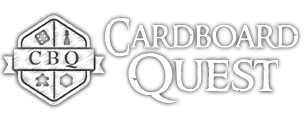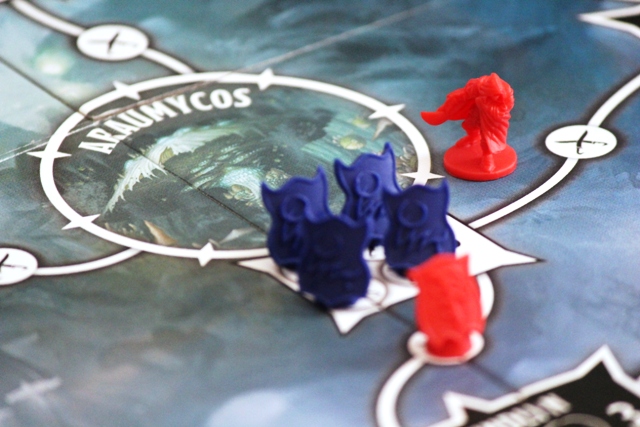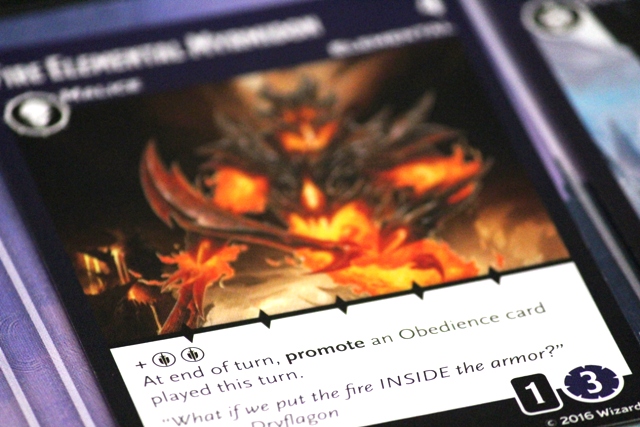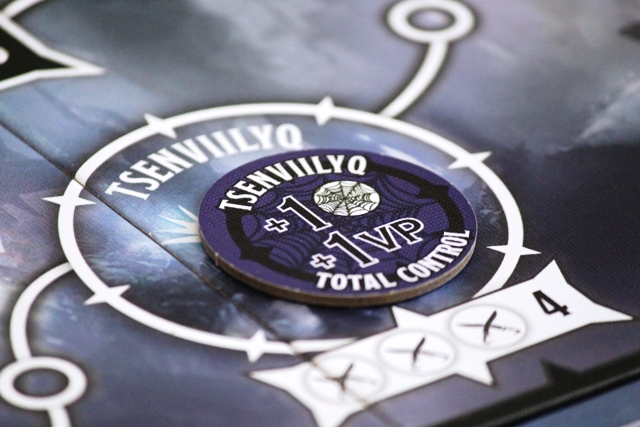Tyrants of the Underdark Review
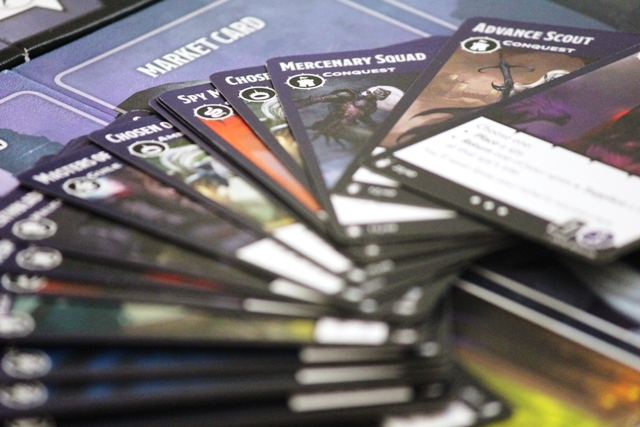
What is it? I'm sure many of us who play a fair number of deckbuilders must have wondered whether adding actual units and a nice big board would inject the genre with healthy dose of freshness. The team behind Lords of Waterdeep also felt this way, and actually did something about it. Tyrants of the Underdark places you in command of a legion of troops and if you're smart, a horde of Demons and Dragons and Elementals. Spread your influence throughout the realm and remind your Drow brethren just what dominion means...
It’s bound to happen to every serious gamer at some point – that game you’ve heard so many good things about finally hits the table and as the last point is jotted down and final tallies calculated, you glance up at your friends hoping to see a similar look in their eyes. What look is that, you might ask? Well, I suppose it’s actually the absence of a look more than anything else. Neither the sparkle of barely contained enthusiasm, nor the solemn look of disappointment. It’s the look embodied by that ubiquitous modern slang term ‘meh’, and it’s the look I shared with three other players as we ended our first game of Tyrants of the Underdark.
And the reason I’m opening with the type of summary usually reserved for closing out a review, is to reiterate the curse that shadows every reviewer, that lurks in the dank recesses of their subconscious, that seeps nightly from out of their closets and beneath their beds – objectivity. It’s never an issue when a game is universally panned, but speak ill of the revered and you toy with bringing down a wrath to shake the pillars of the heavens. I can see why Tyrants is so highly regarded, I can see the expertly crafted gears and cogs ticking away beneath the surface and I can admire the craftsmanship on display. Were there times I uttered out load ‘this is pretty neat’? Yes, there absolutely were. Because it’s true, Tyrants does possess a few interesting twists on established mechanics. So I will strive to highlight both the games strengths and perceived flaws as fairly as I can, but understand that my lens has been coloured with a tinge of indifference. Unlike those fearsome Drow, I’m only human.
Right then, let’s proceed with the easier stuff first. Tyrants of the Underdark is a hybrid style game, which meshes together two very distinct boardgame mechanics in an effort to make the whole greater than the sum of its parts. It’s published by Gale Force Nine, which to their credit is a name you can drop in the industry these days and see ears prick up in attention, and set in the world of Dungeons and Dragons. They’ve established an excellent track record, which in turn brings with it a certain level of expectation. And to add to those levels, Tyrants shares two designers with Lords of Waterdeep, a game that continues to flaunt its reputation around the CBQ offices.
The game blurb is simple enough – lead your Drow house in the act of establishing a vice-like grip on power in that region below the Sword Coast known as the Underdark. You’ll do so by mastering a two-prong attack, recruiting powerful allies and monsters to your cause in a traditional deck-building game, as well as deploying your troops to a map of the region in a game of area control. Cards are worth points, locations are worth points, the final round is triggered once the Market deck is empty or one player has deployed their last troop to the board.
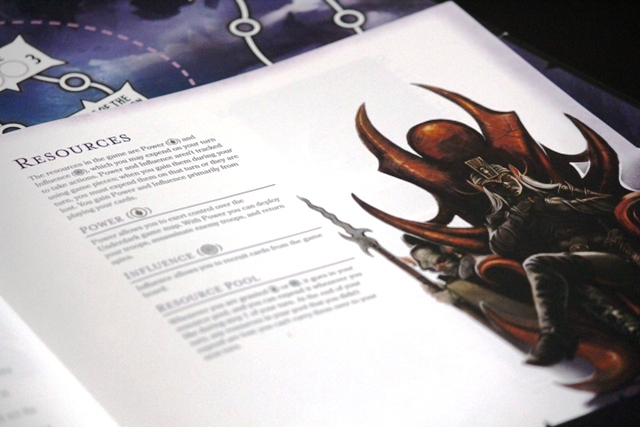
The rulebook is excellent, and I appreciate the included lore around the various Underdark locations
The art on the 260 Minion cards is decent – all very faithful to the D&D style and even though it’s fairly generic, it’s satisfying enough. The board on the other hand leaves much to be desired. I understand there are limitations imposed by the setting, but the blurred blue/black/purple palette in use does little to compliment gameplay nor bring the theme to life. The individual player boards are a nice touch in keeping your deck organised and providing a turn summary, but again the art is hardly evocative.
I also wish they’d given more thought to the choice of player colours – sure greens and yellows are understandably off limits, but the red/orange and blue/black combinations might be problematic in less well-lit conditions. Card stock is poor, but it was the design choice on the card backs that raised eyebrows the most and is quite jarring. As for the plastic pieces, they’re solid enough in a they’ll do the job sort of way. So the components are passable, not likely to offend but even less likely to win any awards. How does the game actually play?
Easily, would be my initial response. And that’s certainly a big black tick in the pros column. Tyrants is an easy game to teach – we barely consulted the rulebook beyond certain term definitions – it’s easy to understand and possesses the immediacy of its waterlogged cousin. Deck setup is your standard deck-building foundation of a starting deck of basic cards, and the marketplace has its own board to keep things neat and tidy. Tyrants operates with two currencies, Influence and Power. Influence being your gold proxy and Power determining what you can do on the board such as deploying or assassinating troops. Slaughter is of course rewarded, with each troop you assassinate worth 1VP. Every game has a board that’s prepopulated by a neutral white faction, so there’s more than enough bloodshed to go around.

When the art is good, it’s VERY good. The card type, which is important for focus abilities, is Conquest, and the card cost is in the top right corner
The Market cards all belong to one of four types and is built by shuffling two of the four deck types together. Most minions provide additional Power or Influence, or a combination of the two, but the more expensive minions also award special abilities such as placing spies, Promoting or Devouring cards, or if you’re lucky Supplanting. Just to touch quickly on those keywords: Devouring allows you to remove a Market card from the game, Supplanting allows you to not only assassinate a troop but replace it with one of your own, and Promoting is probably the mechanic I enjoyed the most, so I’ll elaborate. Players also receive a coaster-like token called the Inner-circle. All cards in the game have two victory point values – one for being in your deck and one for being in your Inner circle, and promoting is the act of placing a card from your hand into the Inner circle. With culling your deck being an integral part of deck-building, it’s unusual to see a game that makes the process an actual strategy for winning.
No self respecting Drow leader should be without a cadre of spies, and Tyrants makes no exceptions here. Unlike troops which need to adhere to adjacency rules, Spies can be deployed anywhere. They don’t even take up a designated spot on the board, choosing instead to lurk from the shadows. And to explain why spies are more often than not a major pain in your ebony Drow derrière, I need to detail the area control aspect of Tyrants. The board has major and minor locations, and spaces linking these. Think a Ticket to Ride or Airplanes Europe style network of spaces where you’re essentially attempting to string a train of your troops from one location to the next. In turn, each of these major or minor locations has any number of spaces between 1 and 6, which means that while transitional spaces can only be occupied by a single troop, locations could have multiple troops vying for control. Minor locations only provide end game VP bonuses, whilst major locations have site control markers in addition.
Control itself comes in two flavours for major locations: a temporary control of sorts that generally provides a bonus of 1 Influence per turn if you have more troops than anyone else in that location, or the better tasting complete control that provides not only an Influence bonus per turn, but victory points too. Complete control requires you occupy every space in a location, and are naturally slightly harder to attain. Place a filthy, filthy spy in a location, and that location cannot be completely controlled even if every space has one of your troops occupying it. And location completely controlled at the end of the game also awards 2 VP, and with sites outnumbering spies, you need to think carefully about their placement.
Turns flow relatively quickly, choose how to spend Influence or Power and whether or not to activate card abilities. Place used and newly purchased cards in your discard pile, draw 5 new cards, curse as the next three opponents all assassinate your troops and play spies to your controlled locations, and carefully cultivate your revenge.
So what did we like about Tyrants? The four deck types provide decent variety, with some introducing new mechanics such as Insane Outcasts which are basically curse cards that force you to discard cards and count for negative VPs, or Focus which increases the potency of a card when played with cards of a matching type. The act of Promoting as I’ve already mentioned, which for me at least provided some of the hardest decisions in the game – do you try to squeeze the maximum benefit from a card and risk running out of the time needed to promote it, or work toward building an engine that’s focused entirely on promoting?
For those who, and they do exist don’t they Stuart, generally don’t like deckbuilders, the addition of the board and area control elements may well offer an improved experience. I also appreciate that even though those deckbuilding aficionados can merrily pursue the engine optimisation they’re no doubt accustomed to, you can absolutely just focus on buying cards that do cool stuff and focus your strategy around troop deployment and surgical strikes.
Where things got a little muddled for us was less about what mechanics did or didn’t work, and more about how we felt playing the game. It surprisingly lacked suspense, turns often felt too mechanical, and at four players you are often unable to impact meaningfully the actions of at least one person at the table until the mid-game point. For as important as those locations are, the ebb and flow of control failed to convey a sense of impact and devolved into a game of chicken, only instead of riding upon the backs of mighty dragons you’re straddling their lettuce-eating, shell-wearing descendants. I assassinate two of your troops and put three of mine down, and on your turn you do pretty much the same. It’s a war of attrition between opponents wielding toothpicks instead of greatswords. Late game opponent interference carries greater weight as a result of your dwindling troops numbers, but for most of the game you simply have so many that losing a few is more bothersome than painful.
Tyrants also lacks a sense of accomplishment. Getting a handful of 8 Influence and being able to purchase that expensive yet powerful minion is cool and all, but I never truly felt like I was seeing a well thought out plan come to fruition, that a series of carefully strategised moves clicked into place. At best, you’re happy that you’ve managed to keep complete control of a major location and are reeling in extra VPs for the turn, but you’re not defeating that super tough brute in Thunderstone, or nailing that last turn Waterdeep cube dash that completes a 20 point quest.
For a game that involves area control and player confrontation, for me it’s an important quality to lack. It may just be that I dislike having no control over what an opponent can and can’t do, that my response is limited to being vindictive and not defensive. If an opponent wants to assassinate 4 of your troops in a single turn, there’s absolutely nothing you can do about it. I’m guessing I’m in the minority in that respect, it’s likely to bother you far less than it bothered me. And again, that’s not a fault of the game or of the game design, simply a preference.
I also feel that more synergy between cards and board might go some way to improving the experience. Whilst there is plenty of synergy between the cards themselves, beyond dictating troop behaviour there’s little else linking the two aspects. I hope future expansions might address this, that controlling certain locations becomes important beyond just the VP bonus but impacts upon how certain cards work, and even perhaps cards that introduce just a touch of asymmetry. You are after all a mighty Drow house, surely something should set you apart from your enemies? Well, it just so happens that two expansion decks are on the way, Aberrations and Undead. Not much detail on either, but one will focus further on forcing opponents to discard, and the other will focus on expendable minions for bursts of power. Greater player interaction can only be a good thing, I may yet be forced to eat my words.
Of the four deck types (Drow, Dragons, Demons and Elementals), the Elemental deck was by some margin the most engaging to play with, which causes me to wonder why you’d ever want to play without it. It elevates card synergy and goes some way toward making your Market place purchases more coherent, so unless you’re playing Tyrants as a gateway game of sorts it offers far more than the Dragon deck, for example. As for player counts, at 4 things seem to drag just a little more than they should for this style of game and it’s not unusual in the late game to have one player take a fairly long time to activate the cards in his hand leaving you twiddling your thumbs for five minutes. 3 is probably ideal, but Tyrants could make for an enjoyable 2 player game as it moves at a decent clip of around 45 minutes per game.
Have I been a touch unfair to Tyrants? Well, I can say that each time I’ve played it the experience has been an improvement, but at the same time it’s also further entrenched the issues I have with the game. Does this mean that after the 7th or 8th game things might click? Potentially, sure. But my enthusiasm, like an unseen sun at dawn in this shadowy Drow realm, has been left cold.
Many thanks to Solarpop for providing a copy for review purposes.
Pros:
- Easy to teach and learn
- Promoting cards is a great addition
- Elemental deck is good fun
- Hybrid mechanics may widen appeal
- Similar gateway appeal to Waterdeep
Cons:
- Card stock is poor
- Not all decks are created equal
- Lacks tension
- Depth not quite there
- Theme doesn’t carry through
